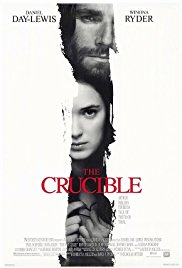QUESTIONS RELATING TO THE WITCHCRAFT TRIALS AS A METAPHOR FOR THE RED SCARE OF 1947 – 1956:
4. Miller reports the following facts at the end of the play:
Twenty years after the last execution, the government awarded compensation to the victims still living and to the families of the dead. However, it is evident that some people still were unwilling to admit their total guilt, and also that the factionalism was still alive, for some beneficiaries were actually not victims at all, but informers ….
[Within 20 years after the witchcraft trials] to all intents and purposes, the power of theocracy in Massachusetts was broken.
How do you account for the facts that Miller notes?
Suggested Response:
As time passed and the hysteria was long gone, people were able to look back and see rationally what had really happened. They no longer felt threatened.
5. Name other situations in which a feeling of hysteria caused the deaths of innocent people?
Suggested Response:
There are many. They include anti-Semitic pogroms in Russia; the Holocaust; the genocide in Cambodia, 1975 to 1997, and the 1994 genocide in Rwanda.
6. Do you believe that the torture of prisoners by U.S. authorities at Abu Ghraib, the prison at Guantanamo and other locations, was justified or did it betray American core values?
Suggested Response:
This is a matter of debate, but most people would answer that torture is against basic American values. In addition, torture has not been shown to be an effective interrogation technique. People in great pain will tell the interrogator anything to get the pain to stop.
7. One of the explanatory paragraphs Miller inserted into his play states the following:
When one rises above the individual villainy displayed, one can only pity them all, just as we [America during the Red Scare] shall be pitied someday. It is impossible for man to organize his social life without repressions, and the balance has yet to be struck between order and freedom.
Identify some social repressions in your life.
Suggested Response:
There is no one correct answer. Examples that students might cite are clothing regulations at schools, restrictions on what students can write in the student newspaper, restrictions on the use of profanity or hate speech, etc. 9. Does the fact that there were a few Soviet spies who may have been able to cause serious harm to the country justify the denial of rights to thousands of innocent individuals? Give your reasons. Suggested Response: A good discussion will include the following: The First Amendment protects the rights to free speech and political association. Membership in the Communist Party has never been illegal. One of the foundations of the American society, from the Founding Fathers onward, has been that it is much worse for innocents to be punished than for some of the guilty to go free. People are considered innocent until proven guilty. The government has many other resources with which to catch spies. As the character of Sir Thomas More in A Man for All Seasons said: “If you tear down all the protections of the law when the wind blows again where will you find shelter?”
QUESTIONS RELATING TO LITERARY ELEMENTS
8. In terms of story, rather than historical accuracy, which character serves as the narrative’s protagonist?
Suggested Response:
John Proctor is the protagonist. The story is his. It is his sexual philandering that rouses Abigail to generate the hysteria against witchcraft, he is the one who grows in terms of honor, and it is through his character that the moral lessons of the play are taught.
9. Which character serves as the antagonist?
Suggested Response:
Abigail is the antagonist. Her desire to seek revenge against John Proctor or to win his affections causes the tension in the film and provokes the changes in both John and his wife, Elizabeth, that create theme. It could also be said that the community which allows itself to become the prosecutor of John Proctor is also the antagonist. Abigail acts through the community.
10. What gives Abigail the power to disrupt the community and to get many young women to follow her lead in claiming witchcraft?
Suggested Response:
Answers will vary. Students may suggest that a general sense of sexual repression existed in the time period in which the film is set and this may have given rise to pent up sexual frustrations released in the hysteria. The opening scene, with the fire and nude dancing exemplifies this. Guilt may have been a factor as well as fear of reprisal. It was easier for these girls to blame witchcraft for sexual longing than to admit the feelings themselves. Others may decide that John Proctor gave Abigail the power to provoke the hysteria with his sexuality and by his provocative behavior; Abigail seems to believe that it is Elizabeth Proctor who keeps John away from her, rather than his own desire.
11. In what ways does Elizabeth Proctor change through the course of the story?
Suggested Response:
Elizabeth Proctor is a cold and punitive woman until the moment she realizes that her husband is threatened. At this point she lies to protect him, choosing to value love over honesty. Ironically, this dooms her husband. She then forgives him for his adultery, admits her feelings of jealousy and insecurity, apologizes for her coldness and encourages him to remain true to himself. Her redemption results in her death.
12. Before Elizabeth forgives him, Proctor is willing to sign the false confession in order to save his life and hers. But after she forgives him he chooses to die rather than to admit to something he didn’t do. Can you explain this change of mind?
Suggested Response:
Here is one explanation. Once his wife absolves him of his guilt, Proctor is able to regain his self-respect and act according to his higher nature. He will not falsely name others. In his refusal, with his new found self-respect, he comes to the point where he will not name himself; he tears up the confession and gets on the wagon with the other doomed townspeople.
13. What irony can be found in the scene in which John Proctor and two others are hanged?
Suggested Response:
The three condemned citizens are reciting the Lord’s Prayer which includes the words: “Forgive us our trespasses as we forgive those who trespass against us.” This recitation brings into clear focus the merciless, even murderous nature of the good Christian people of the village who are watching the hanging. Those being trespassed against are doing the forgiving.
TWM’s Standard Questions for Use With Any Film That is a Work of Fiction and Lesson Plans Using Film Adaptations of Novels, Short Stories or Plays help stimulate student interest and assist in the exploration of characterization, plot, theme, and other literary devices.



